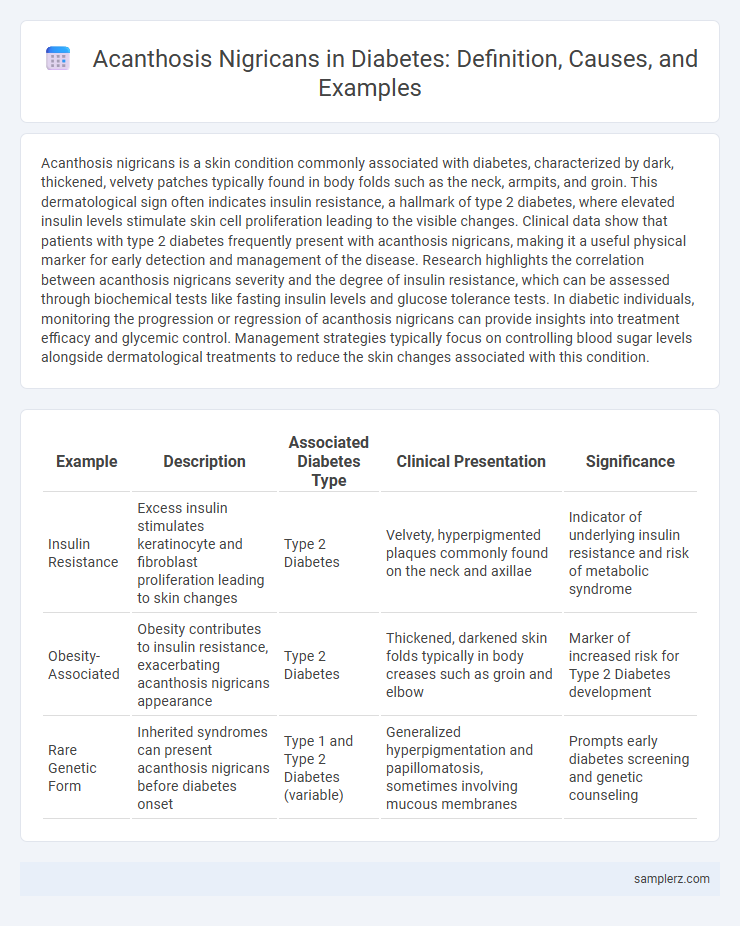Acanthosis nigricans is a skin condition commonly associated with diabetes, characterized by dark, thickened, velvety patches typically found in body folds such as the neck, armpits, and groin. This dermatological sign often indicates insulin resistance, a hallmark of type 2 diabetes, where elevated insulin levels stimulate skin cell proliferation leading to the visible changes. Clinical data show that patients with type 2 diabetes frequently present with acanthosis nigricans, making it a useful physical marker for early detection and management of the disease. Research highlights the correlation between acanthosis nigricans severity and the degree of insulin resistance, which can be assessed through biochemical tests like fasting insulin levels and glucose tolerance tests. In diabetic individuals, monitoring the progression or regression of acanthosis nigricans can provide insights into treatment efficacy and glycemic control. Management strategies typically focus on controlling blood sugar levels alongside dermatological treatments to reduce the skin changes associated with this condition.
Table of Comparison
| Example | Description | Associated Diabetes Type | Clinical Presentation | Significance |
|---|---|---|---|---|
| Insulin Resistance | Excess insulin stimulates keratinocyte and fibroblast proliferation leading to skin changes | Type 2 Diabetes | Velvety, hyperpigmented plaques commonly found on the neck and axillae | Indicator of underlying insulin resistance and risk of metabolic syndrome |
| Obesity-Associated | Obesity contributes to insulin resistance, exacerbating acanthosis nigricans appearance | Type 2 Diabetes | Thickened, darkened skin folds typically in body creases such as groin and elbow | Marker of increased risk for Type 2 Diabetes development |
| Rare Genetic Form | Inherited syndromes can present acanthosis nigricans before diabetes onset | Type 1 and Type 2 Diabetes (variable) | Generalized hyperpigmentation and papillomatosis, sometimes involving mucous membranes | Prompts early diabetes screening and genetic counseling |
Understanding Acanthosis Nigricans in Diabetes
Acanthosis nigricans is a skin condition characterized by dark, thickened patches commonly found in body folds such as the neck, armpits, and groin, often signaling underlying insulin resistance in diabetes. Its presence frequently indicates poorly controlled type 2 diabetes or prediabetes, serving as an important clinical marker for early intervention. Managing blood glucose levels effectively can reduce the severity of acanthosis nigricans and improve overall skin health in diabetic patients.
Common Sites of Acanthosis Nigricans in Diabetic Patients
Common sites of acanthosis nigricans in diabetic patients include the posterior neck, axillae, and groin, where hyperpigmented, velvety plaques frequently develop. These skin changes often correlate with insulin resistance and poor glycemic control, serving as valuable clinical indicators of underlying metabolic dysfunction. Recognizing these characteristic locations aids in early diagnosis and effective management of diabetes-related complications.
Skin Changes: Early Signs of Insulin Resistance
Acanthosis nigricans manifests as dark, velvety patches commonly found in body folds such as the neck and armpits, serving as an early dermatological indicator of insulin resistance in diabetes. These skin changes result from hyperinsulinemia stimulating keratinocyte and dermal fibroblast proliferation. Monitoring for acanthosis nigricans enables earlier diagnosis and management of type 2 diabetes by addressing underlying metabolic abnormalities.
How Diabetes Triggers Acanthosis Nigricans
Diabetes triggers acanthosis nigricans through insulin resistance, which leads to hyperinsulinemia and stimulates the proliferation of keratinocytes and dermal fibroblasts. Elevated insulin levels activate insulin-like growth factor receptors in the skin, promoting hyperpigmentation and thickening characteristic of acanthosis nigricans. This skin condition often appears in diabetic patients, particularly in areas such as the neck, axillae, and groin, serving as a clinical marker of underlying metabolic dysfunction.
Visual Clues: Identifying Acanthosis Nigricans in Diabetics
Acanthosis nigricans in diabetic patients typically presents as velvety, hyperpigmented plaques with a dark brown to black coloration, most commonly found on the neck, axillae, and groin areas. These skin changes often serve as visual clues indicating underlying insulin resistance and poorly controlled type 2 diabetes mellitus. Early recognition of these dermatological signs can prompt timely metabolic screening and intervention to manage diabetes effectively.
Photographic Examples: Acanthosis Nigricans and Diabetes
Photographic examples of acanthosis nigricans in diabetes often highlight hyperpigmented, velvety plaques predominantly located on the neck, axillae, and groin regions. These skin manifestations correlate strongly with insulin resistance in type 2 diabetes, serving as visible markers for clinicians to identify underlying metabolic disturbances. Clinical images facilitate early diagnosis and targeted management by demonstrating characteristic skin changes associated with hyperinsulinemia.
Clinical Case Studies: Acanthosis Nigricans Linked to Diabetes
Acanthosis nigricans presents as hyperpigmented, velvety plaques typically found in the neck and axillae of patients with insulin resistance, frequently observed in type 2 diabetes mellitus cases. Clinical case studies reveal that the severity of acanthosis nigricans often correlates with poor glycemic control and elevated fasting insulin levels. Early recognition of these dermatologic signs in diabetic patients facilitates timely intervention to improve metabolic outcomes and prevent complications.
Key Differences Between Diabetic and Non-Diabetic Acanthosis Nigricans
Diabetic acanthosis nigricans typically presents with velvety, hyperpigmented plaques in body folds such as the neck and axilla, often correlating with insulin resistance and elevated blood glucose levels. Non-diabetic acanthosis nigricans may arise from genetic factors, obesity, or malignancies, displaying similar skin changes but without the metabolic disturbances seen in diabetes. The key difference lies in the underlying pathophysiology, where diabetic acanthosis is driven by hyperinsulinemia stimulating keratinocyte proliferation, whereas non-diabetic forms may lack this metabolic trigger.
Managing Acanthosis Nigricans in Diabetic Individuals
Managing acanthosis nigricans in diabetic individuals involves strict glycemic control to reduce insulin resistance, which is the primary underlying cause. Topical treatments such as retinoids or keratolytic agents can improve skin texture, while addressing obesity through diet and exercise significantly decreases symptom severity. Regular monitoring by healthcare providers ensures early intervention and prevents progression of both diabetes and acanthosis nigricans.
When Acanthosis Nigricans Signals Uncontrolled Diabetes
Acanthosis nigricans often appears as dark, thickened patches of skin in body folds, signaling insulin resistance commonly seen in uncontrolled diabetes. This dermatological condition typically manifests in the neck, armpits, and groin, indicating elevated blood glucose levels and impaired insulin function. Recognizing acanthosis nigricans early can prompt timely diabetes management to prevent complications.

example of acanthosis nigricans in diabetes Infographic
 samplerz.com
samplerz.com